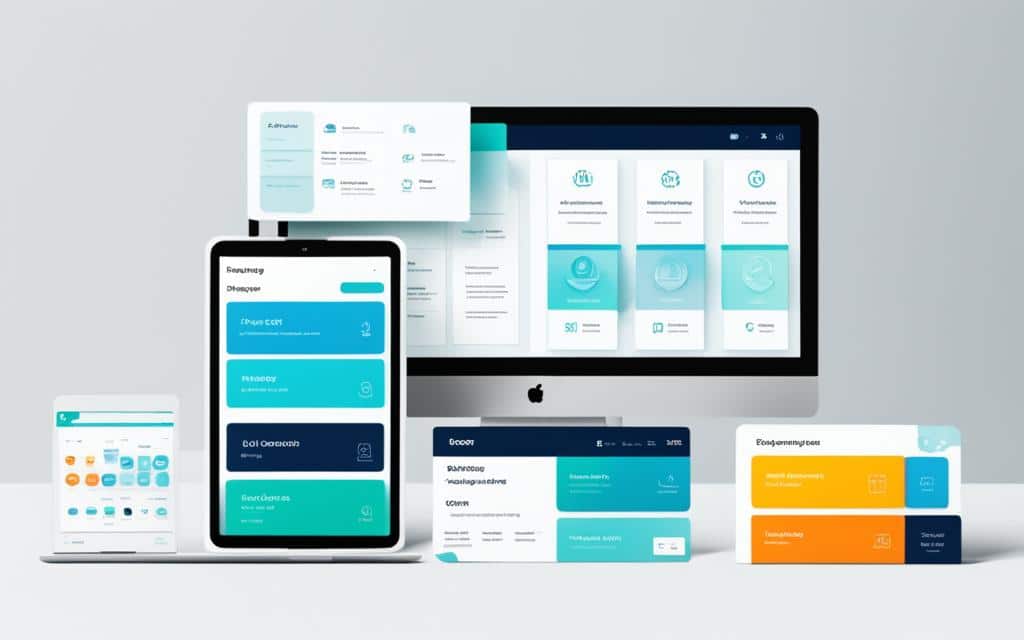Table of Contents
In the ever-evolving landscape of digital design, the convergence of User Interface (UI), User Experience (UX), and Brand Identity has emerged as a dynamic and transformative force. The way users interact with digital platforms goes beyond functionality; it is a holistic experience that encompasses aesthetics, emotions, and values. The harmonious integration of UI/UX and Brand Identity not only shapes how users engage with a product or service but also defines the essence of the brand itself.
Branding and User Experience (UX) design are essential components of creating impactful digital experiences. By blending strategic branding principles with intuitive and user-centered design, businesses can establish a strong brand presence and deliver exceptional user experiences. In this article, we will explore how branding and user experience design intersect and how this intersection influences digital experiences.
The Essence of Brand Identity
Brand Identity plays a crucial role in shaping the way consumers perceive and connect with a brand. It encompasses both visual and emotional elements that leave a lasting impression in the minds of users. By effectively utilizing visual elements such as logos, color palettes, typography, and tone of voice, Brand Identity becomes a powerful tool that communicates a brand’s values, personality, and promises.
Visual elements are the face of a brand, creating a visual language that resonates with users and differentiates the brand from its competitors. Logos, for example, act as a symbol that represents the brand’s essence and becomes instantly recognizable. Color palettes and typography choices evoke certain emotions and associations, further reinforcing the brand’s identity.
However, Brand Identity goes beyond aesthetics. It also encompasses the emotional connection users have with the brand. The values, mission, and promises conveyed by a brand play a significant role in shaping the perception and trust users have in the brand.
“Brand Identity is all about creating a cohesive and authentic representation of a brand. It’s about communicating the brand’s values, personality, and promises to establish a strong connection with the audience.” – Emily Smith, Branding Specialist
Through the strategic use of visual and emotional elements, Brand Identity shapes the way users perceive and connect with a brand. It influences their decision-making process, building trust, and establishing a sense of loyalty. When a brand’s values align with those of its targeted audience, it fosters a deeper connection and creates lasting brand perception.
The Role of Visual Elements
Visual elements are the building blocks of Brand Identity. They capture the brand’s personality and help create a consistent and recognizable visual identity. Let’s explore some of the key visual elements that contribute to a brand’s identity:
- Logos: Logos are the face of a brand. They act as a symbol that represents the brand’s values and mission. A well-designed logo is memorable, versatile, and instantly recognizable.
- Color Palettes: Colors evoke emotions and associations. A carefully chosen color palette can create a specific mood, convey the brand’s personality, and differentiate it from competitors.
- Typography: Typography choices influence the brand’s tone of voice and overall aesthetics. Different fonts elicit different emotions and help communicate the brand’s values and messaging.
By harmoniously combining these visual elements, brands can create a cohesive and distinctive visual identity that sets them apart from others in the market.
The Role of UI/UX Design
UI/UX design plays a crucial role in crafting exceptional digital experiences that go beyond aesthetics. It encompasses the orchestration of the user journey, shaping how users interact with a digital platform. While UI design focuses on the visual elements and aesthetics, UX design prioritizes usability, accessibility, and overall user satisfaction. When these two aspects work in synergy, they create impactful and user-centric experiences that align with the brand’s objectives and resonate with its target audience.
At its core, UI/UX design aims to create intuitive and seamless user interactions that enhance usability. By considering the user journey from start to finish, designers have the opportunity to anticipate user needs, pain points, and motivations, resulting in well-crafted user experiences that simplify complex tasks and empower users.
Usability is a key component of UI/UX design. It ensures that users can easily navigate and interact with a digital platform, promoting efficiency and effectiveness. By integrating intuitive navigation, streamlined workflows, and clear calls-to-action, designers enhance the overall usability of a product or service, making it more accessible and enjoyable for users.
“Good design is as little design as possible.” – Dieter Rams
To achieve exceptional user satisfaction, UI/UX design approaches are rooted in empathizing with users and understanding their needs, preferences, and expectations. By conducting user research, designers gain valuable insights into user behaviors, motivations, and pain points, which inform the design decisions and improve the overall user experience.
A well-executed UI/UX design not only facilitates positive user interactions but also establishes trust and credibility. It reflects the brand’s values, voice, and visual identity, creating a cohesive and authentic digital experience. By incorporating consistent branding elements, such as colors, typography, and imagery, designers reinforce brand recognition and strengthen the emotional connection between users and the brand.
Creating a User-Centric Design
A user-centric design approach requires designers to prioritize the needs of the end-users throughout the design process. By considering user feedback, conducting usability testing, and iterating on design solutions, designers can continuously improve the user experience and ensure user satisfaction.
Effective UI/UX design considers various user personas and tailors the experience accordingly. By understanding the target audience’s demographics, preferences, and motivations, designers can create personalized experiences that resonate with different user segments.
Furthermore, UI/UX design should also address accessibility considerations to ensure that all users can engage with the digital platform, regardless of their abilities or limitations. This includes incorporating features such as alternative text for images, captioning for videos, and proper contrast for readability.
Ultimately, UI/UX design leaves a lasting impact on user satisfaction and the overall success of a digital product or service. By thoughtfully designing the user journey, prioritizing usability, and aligning with the brand’s identity, UI/UX design creates memorable experiences that foster meaningful connections between users and brands.
A Cohesive Visual Language
When it comes to UI design, elements such as colors, typography, and layout play a significant role in shaping the overall user experience. But what happens when these design elements mirror the brand identity? It creates a cohesive visual language that not only enhances the aesthetics but also reinforces brand recognition and familiarity.
Consistency in visual elements is key to establishing a strong brand presence across digital platforms. When users encounter consistent design elements that align with the brand’s identity, they develop a sense of trust and familiarity. This consistency also helps users navigate the interface more easily, creating a seamless user experience.
A cohesive visual language achieved through visual design consistency is crucial for brand recognition. Users should be able to recognize and associate visual elements with the brand effortlessly. By creating a consistent visual identity, brands establish a strong presence in users’ minds, which leads to increased brand recall and recognition.
User trust is another vital aspect that a cohesive visual language contributes to. When users see a familiar and consistent visual design throughout their interactions with a brand, it instills a sense of reliability and professionalism. This, in turn, enhances user trust in the brand, making them more likely to engage, convert, and maintain a lasting relationship.
“Visual consistency is not about sameness, but about creating a coherent and recognizable look and feel that connects users to the brand.”
A cohesive visual language is not just about aesthetics; it plays a crucial role in building user trust and reinforcing brand recognition. By aligning UI design elements with the brand identity, brands can create a consistent and impactful user experience that fosters lasting relationships with their audience.
Emotional Resonance
In the realm of UI/UX design, emotional impact plays a pivotal role in creating meaningful user experiences. By strategically incorporating elements of Brand Identity, designers have the power to forge a deep connection between users and a brand. Through careful use of imagery, messaging, and interactions, designers can elicit specific emotions that resonate with the brand’s intended emotional connection with users.
Strategic use of visuals is key to evoking emotional responses. By leveraging compelling imagery that aligns with a brand’s values and story, designers can capture users’ attention and spark an emotional connection from the moment they engage with a digital platform. Colors, typography, and graphic elements can all be harnessed to evoke specific emotions, whether it’s excitement, trust, serenity, or any other desired feeling.
Designers have the power to shape users’ emotional journey, guiding them through an experience that aligns with the brand’s overarching narrative and identity.
Additionally, messaging plays a crucial role in establishing an emotional connection. The tone of voice, choice of words, and storytelling techniques can all influence how users perceive and connect with a brand. Through compelling and authentic storytelling, a brand can tap into users’ emotions, forging a deeper connection and leaving a lasting impact.
The Role of Interactions
Another powerful tool for evoking emotions is the strategic use of interactions. Through intuitive and immersive interactions, designers can create experiences that resonate with users on a personal level. Microinteractions, animations, and transitions can add a layer of delight and surprise, eliciting positive emotions and enhancing the overall user experience.
Interactions can also be used to communicate empathy and understanding. By designing interactions that respond to users’ needs, preferences, and behaviors, designers can make users feel seen and valued. This personalized approach fosters a sense of empathy and connection, further strengthening the emotional bond between users and a brand.
Driving User Engagement Through Emotional Resonance
Emotional resonance in UI/UX design plays a crucial role in driving user engagement. When users feel an emotional connection with a brand, they are more likely to become advocates, loyal customers, and active participants in the brand’s community. By designing experiences that evoke positive emotions, brands can create a ripple effect that spurs user engagement, amplifies brand recognition, and fosters long-term relationships.
Strategically utilizing emotional resonance in UI/UX design is not only about evoking positive emotions but also about creating experiences that align with a brand’s values and purpose. Authenticity, empathy, and consistency are key pillars in establishing a strong emotional connection that resonates with users and cultivates lasting relationships.
Conclusion
The intersection of UI/UX and Brand Identity marks the convergence of creativity, strategy, and user-centricity. When these two elements harmoniously blend, they create an experience that goes beyond aesthetics; it communicates the brand’s essence, values, and promises. The relationship between UI/UX and Brand Identity is symbiotic, with each enhancing and amplifying the other’s impact. Designers who master this intersection have the power to shape not only exceptional user experiences but also lasting and meaningful relationships between users and brands.
Exceptional user experiences are the result of thoughtful UI/UX design that takes into consideration the brand’s core identity and values. By aligning the visual and functional aspects of a digital platform with the brand’s essence, designers can create experiences that captivate users and elicit an emotional response. These exceptional user experiences not only build trust and loyalty but also foster lasting connections between users and brands.
Brand Identity serves as the guiding force behind UI/UX design, providing the framework within which designers can create engaging and intuitive experiences. A cohesive visual language that reflects the brand’s visual elements and messaging enhances brand recognition and familiarity, instilling confidence and trust in users. By strategically integrating Brand Identity into the user journey, designers can forge lasting relationships and cultivate brand advocates.
In conclusion, the seamless integration of UI/UX and Brand Identity is essential in creating exceptional user experiences that drive lasting relationships between users and brands. By leveraging the power of creativity, strategy, and user-centricity, designers have the ability to shape digital experiences that not only captivate users visually but also resonate with them emotionally. The intersection of UI/UX and Brand Identity unlocks the potential for brands to leave a lasting impact and forge meaningful connections with their audience, propelling them towards success in the ever-evolving digital landscape.
FAQ
What is the intersection of Branding and User Experience Design?
The intersection of Branding and User Experience Design is the harmonious integration of UI/UX and Brand Identity in digital design. It involves blending the visual and emotional elements of Brand Identity with the user-focused design principles of UI/UX, shaping how users engage with a product or service and defining the essence of the brand itself.
What does Brand Identity encompass?
Brand Identity encompasses the visual and emotional elements that distinguish a brand in the minds of consumers. It includes logos, color palettes, typography, and tone of voice. Brand Identity communicates a brand’s values, personality, and promises, shaping how users perceive and connect with the brand.
What is the role of UI/UX Design?
UI/UX design orchestrates the entire user journey and shapes how users interact with a digital platform. UI design focuses on aesthetics and visual elements, while UX design prioritizes usability, accessibility, and overall user satisfaction. The synergy of UI/UX design ensures that user interactions align with the brand’s objectives and resonate with its target audience.
How does a cohesive visual language enhance a brand?
A cohesive visual language, achieved through consistent UI design elements such as colors, typography, and layout, reinforces brand recognition and familiarity. This enhances user trust and loyalty by creating a unified and recognizable brand experience across different touchpoints.
How does emotional resonance come into play with UI/UX Design?
Emotional resonance is seamlessly woven into UI/UX design through strategic use of imagery, messaging, and interactions. Designers can evoke specific emotions that align with the brand’s intended emotional connection with users, enhancing user engagement and creating a deeper, more meaningful brand experience.
What is the significance of the relationship between UI/UX and Brand Identity?
The relationship between UI/UX and Brand Identity is symbiotic. When these two elements harmoniously blend, they create an experience that goes beyond aesthetics. It effectively communicates the brand’s essence, values, and promises, leading to exceptional user experiences and fostering lasting and meaningful relationships between users and brands.













